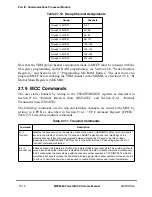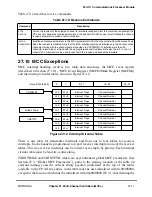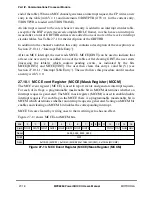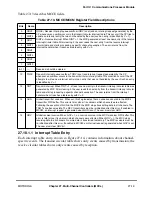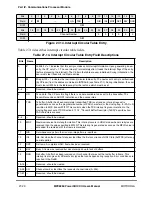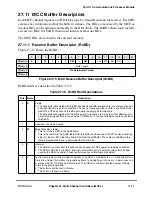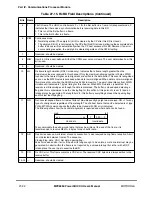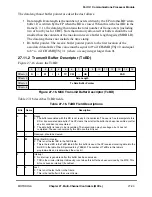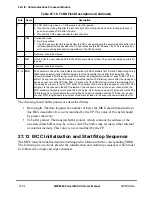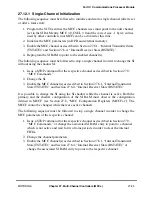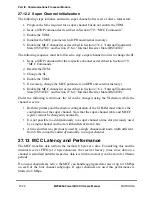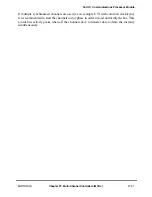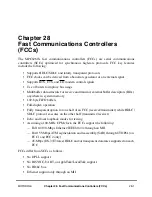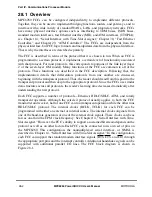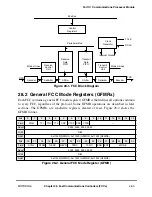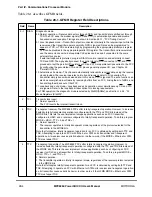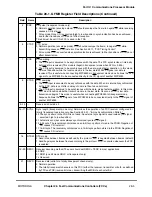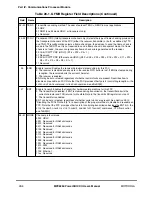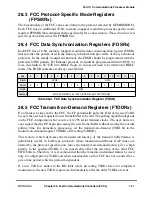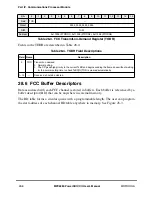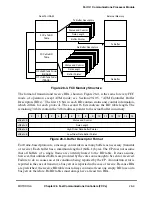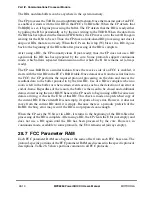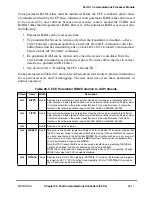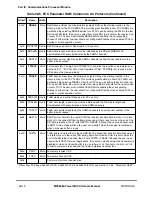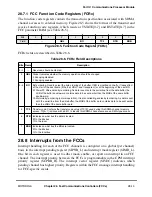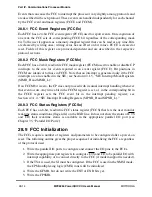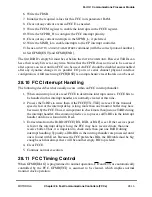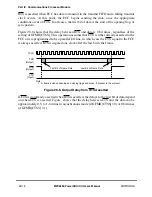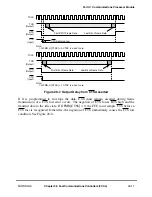
28-2
MPC8260 PowerQUICC II UserÕs Manual
MOTOROLA
Part IV. Communications Processor Module
28.1 Overview
MPC8260 FCCs can be conÞgured independently to implement different protocols.
Together, they can be used to implement bridging functions, routers, and gateways, and to
interface with a wide variety of standard WANs, LANs, and proprietary networks. FCCs
have many physical interface options such as interfacing to TDM buses, ISDN buses,
standard modem interfaces, fast Ethernet interface (MII), and ATM interfaces (UTOPIA);
see Chapter 14, ÒSerial Interface with Time-Slot Assigner,Ó Chapter 30, ÒFast Ethernet
Controller,Ó and Chapter 29, ÒATM Controller.Ó The FCCs are independent from the
physical interface, but FCC logic formats and manipulates data from the physical interface.
That is why the interfaces are described separately.
The FCC is described in terms of the protocol that it is chosen to run. When an FCC is
programmed to a certain protocol, it implements a certain level of functionality associated
with that protocol. For most protocols, this corresponds to portions of the link layer (layer
2 of the seven-layer OSI model). Many functions of the FCC are common to all of the
protocols. These functions are described in the FCC description. Following that, the
implementation details that differentiate protocols from one another are discussed,
beginning with the transparent protocol. Thus, the reader should read from this point to the
transparent protocol and then skip to the appropriate protocol. Since the FCCs use similar
data structures across all protocols, the reader's learning time decreases dramatically after
understanding the Þrst protocol.
Each FCC supports a number of protocolsÑEthernet, HDLC/SDLC, ATM, and totally
transparent operation. Although the selected protocol usually applies to both the FCC
transmitter and receiver, half of one FCC can run transparent operation while the other runs
HDLC/SDLC protocol. The internal clocks (RCLK, TCLK) for each FCC can be
programmed with either an external or internal source. The internal clocks originate from
one of the baud-rate generators or one of the external clock signals. These clocks can be as
fast as one-third the CPM clock frequency. See Chapter 14, ÒSerial Interface with Time-
Slot Assigner.Ó However, the FCCÕs ability to support a sustained bit stream depends on the
protocol as well as on other factors.Each FCC can be connected to its own set of pins on
the MPC8260. This conÞguration, the nonmultiplexed serial interface, or NMSI, is
described in Chapter 14, ÒSerial Interface with Time-Slot Assigner.Ó In this conÞguration,
each FCC can support the standard modem interface signals (RTS, CTS, and CD) through
the appropriate port pins and the interrupt controller. Additional handshake signals can be
supported with additional parallel I/O lines. The FCC block diagram is shown in
Figure 28-1.
Содержание MPC8260 PowerQUICC II
Страница 1: ...MPC8260UM D 4 1999 Rev 0 MPC8260 PowerQUICC II UserÕs Manual ª ª ...
Страница 32: ...xxxii MPC8260 PowerQUICC II UserÕs Manual MOTOROLA CONTENTS Paragraph Number Title Page Number ...
Страница 66: ...lxvi MPC8260 PowerQUICC II UserÕs Manual MOTOROLA ...
Страница 88: ...1 18 MPC8260 PowerQUICC II UserÕs Manual MOTOROLA Part I Overview ...
Страница 120: ...2 32 MPC8260 PowerQUICC II UserÕs Manual MOTOROLA Part I Overview ...
Страница 138: ...Part II iv MPC8260 PowerQUICC II UserÕs Manual MOTOROLA Part II Configuration and Reset ...
Страница 184: ...4 46 MPC8260 PowerQUICC II UserÕs Manual MOTOROLA Part II ConÞguration and Reset ...
Страница 202: ...Part III vi MPC8260 PowerQUICC II UserÕs Manual MOTOROLA Part III The Hardware Interface ...
Страница 266: ...8 34 MPC8260 PowerQUICC II UserÕs Manual MOTOROLA Part III The Hardware Interface ...
Страница 382: ...10 106 MPC8260 PowerQUICC II UserÕs Manual MOTOROLA Part III The Hardware Interface ...
Страница 392: ...11 10 MPC8260 PowerQUICC II UserÕs Manual MOTOROLA Part III The Hardware Interface ...
Страница 430: ...Part IV viii MOTOROLA Part IV Communications Processor Module ...
Страница 490: ...14 36 MPC8260 PowerQUICC II UserÕs Manual MOTOROLA Part IV Communications Processor Module ...
Страница 524: ...17 10 MPC8260 PowerQUICC II UserÕs Manual MOTOROLA Part IV Communications Processor Module ...
Страница 556: ...18 32 MPC8260 PowerQUICC II UserÕs Manual MOTOROLA Part IV Communications Processor Module ...
Страница 584: ...19 28 MPC8260 PowerQUICC II UserÕs Manual MOTOROLA Part IV Communications Processor Module ...
Страница 632: ...21 24 MPC8260 PowerQUICC II UserÕs Manual MOTOROLA Part IV Communications Processor Module ...
Страница 652: ...22 20 MPC8260 PowerQUICC II UserÕs Manual MOTOROLA Part IV Communications Processor Module ...
Страница 668: ...23 16 MPC8260 PowerQUICC II UserÕs Manual MOTOROLA Part IV Communications Processor Module ...
Страница 758: ...27 28 MPC8260 PowerQUICC II UserÕs Manual MOTOROLA Part IV Communications Processor Module ...
Страница 780: ...28 22 MPC8260 PowerQUICC II UserÕs Manual MOTOROLA Part IV Communications Processor Module ...
Страница 874: ...29 94 MPC8260 PowerQUICC II UserÕs Manual MOTOROLA Part IV Communications Processor Module ...
Страница 920: ...31 18 MPC8260 PowerQUICC II UserÕs Manual MOTOROLA Part IV Communications Processor Module ...
Страница 980: ...A 4 MPC8260 PowerQUICC II UserÕs Manual MOTOROLA Appendixes ...
Страница 1002: ...Index 22 MPC8260 PowerQUICC II UserÕs Manual MOTOROLA INDEX ...
Страница 1006: ......

